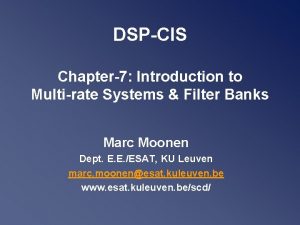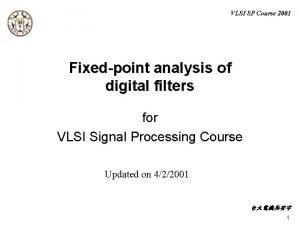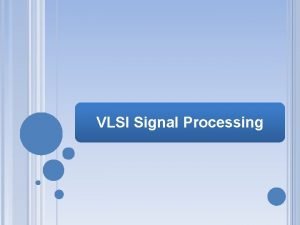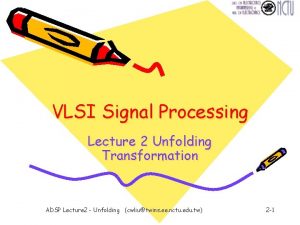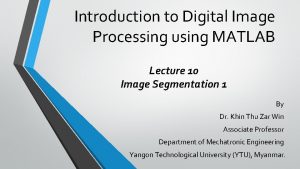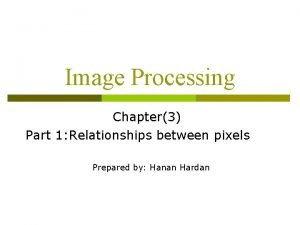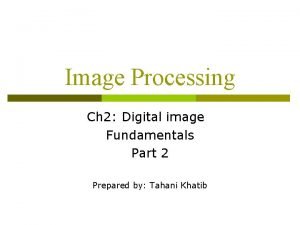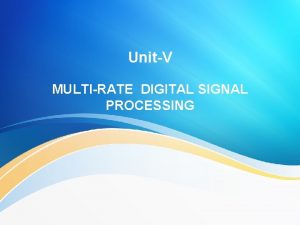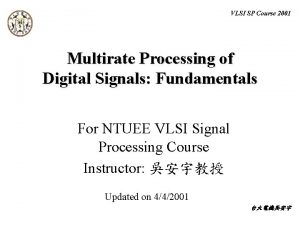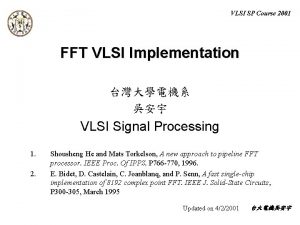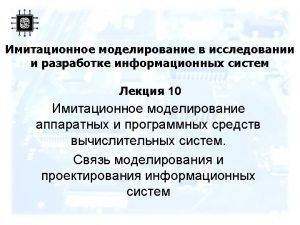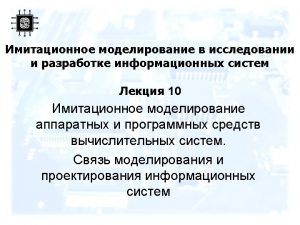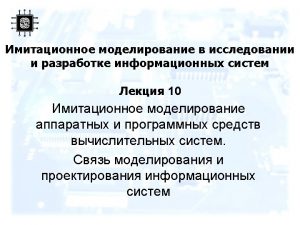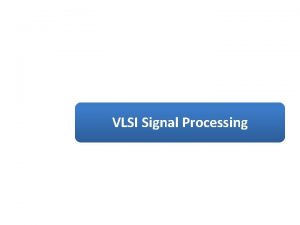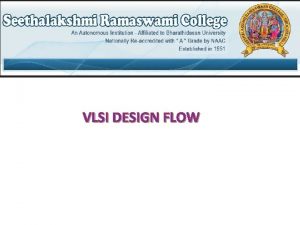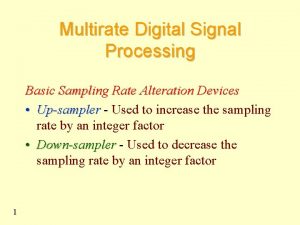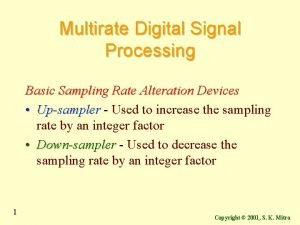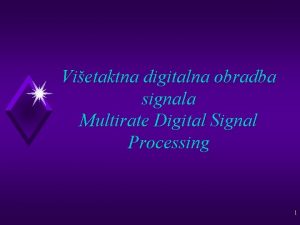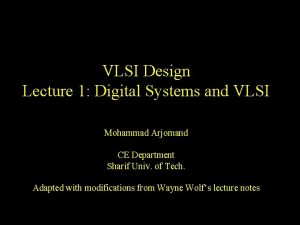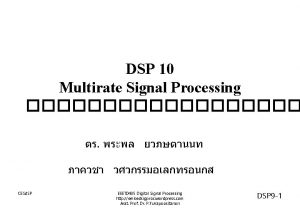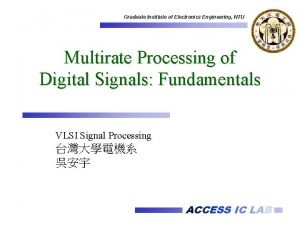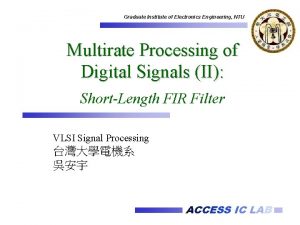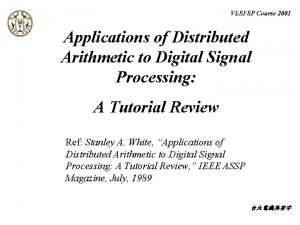VLSI SP Course 2001 Multirate Processing of Digital






























- Slides: 30

VLSI SP Course 2001 Multirate Processing of Digital Signals: Fundamentals For NTUEE VLSI Signal Processing Course Instructor: 吳安宇教授 台大電機吳安宇

VLSI SP Course 2001 Outline • • • Introduction Sampling Rate Conversion Multistage Implementation Practice Structure Polyphase Implementation 台大電機吳安宇

VLSI SP Course 2001 Motivation • Definition – More than one sampling rate (clock) are used in a system Module 1 ? Module 2 clock 1 clock 2 台大電機吳安宇

VLSI SP Course 2001 Conversion Approach • Analog approach • Digital approach (multirate DSP system) 台大電機吳安宇

VLSI SP Course 2001 Analog Approach Advantages Simple Straightforward Arbitrary sampling rate Disadvantages D/A & A/D converter are needed Ideal (near perfect) lowpass filter is needed Introduced noise and distortion 台大電機吳安宇

VLSI SP Course 2001 Digital Approach • Sampling rate conversion – Interpolation • Increase the sampling rate – Decimation • Decrease the sampling rate 台大電機吳安宇

VLSI SP Course 2001 Sampling Theory • If the highest frequency component in a signal is fmax, then the signal should be sampled at the rate of at least 2 fmax for the samples to describe the signal completely, i. e. , For Fs < 2 fmax, alias occurs in the sampling process. Alias Distortion (aliasing) 台大電機吳安宇

VLSI SP Course 2001 Aliasing X(f) f -Fs fmax Fs 台大電機吳安宇

VLSI SP Course 2001 Interpolation by L L h(m) 台大電機吳安宇

VLSI SP Course 2001 Interpolation by L L h(m) 台大電機吳安宇

VLSI SP Course 2001 Decimation by M h(m) M 台大電機吳安宇

VLSI SP Course 2001 Decimation by M h(m) M 台大電機吳安宇

VLSI SP Course 2001 Conversion by a Rational Factor M/L Cascade of two process L h 1(m) Interpolation by L h 2(m) M Decimation by M 台大電機吳安宇

VLSI SP Course 2001 Conversion by a Rational Factor M/L A more efficiency implementation L h (m) M 台大電機吳安宇

VLSI SP Course 2001 Multistage Implementation L L 1 h(m) L 2 h 1(m) LI L 2 h 2(m) h(m) L 1 h 1(m) 台大電機吳安宇

VLSI SP Course 2001 Multistage Implementation Advantages Reduce the complexity Reduce storage devices (registers) Simplify (relax) filter design problem Reduce the finite wordlength effect Disadvantages Increase the control circuit Difficulty in choosing I and best Lj for 1 i I 台大電機吳安宇

VLSI SP Course 2001 Interpolated FIR (IFIR) Approach Nothing to do with interpolation and decimation Conceptually similar Suitable for narrowband FIR filter design LPF HPF BPF 台大電機吳安宇

VLSI SP Course 2001 Application: Interpolated FIR (IFIR) Desired narrowband response Assume required filter order is N. Stretched filter Required filter order is reduced to N/2. Desired Undesired Interpolated version of stretched filter Required filter order is still N/2. Image suppresser Required filter order is M. Order (N/2+M) is needed to implement! (N/2+M) << N for small M 台大電機吳安宇

VLSI SP Course 2001 Interpolated FIR (IFIR) (a) G(z 2) (b) I(z) (a) G(z 2)I(z) 台大電機吳安宇

VLSI SP Course 2001 Interpolated FIR (IFIR) IFIR Method Quantity Compared Conventional Method G(z) I(z) Total Filter order 233 131 6 268 Number of Multipliers 117 66 4 70 Number of Adders 233 131 6 137 台大電機吳安宇

VLSI SP Course 2001 Some Useful Operations Duality and Transposition A dual system is that performs a complementary operation to that of an original system, and it can be constructed form the original system through the process of transposition. The transposition operation is one in which the direction of all branches in the network are reversed, and the roles of the input and output of the network are interchanged. 台大電機吳安宇

VLSI SP Course 2001 Duality and Transposition transposition z-1 z-1 z-1 台大電機吳安宇

VLSI SP Course 2001 Duality and Transposition They are not true in time-varying system, but can be treated as sampling rate reverse process. transposition L L transposition M M transposition h(n) M transposition L h(n) M 台大電機吳安宇

VLSI SP Course 2001 Practical Structure Decimation h(n) M z-1 M z-1 M z-1 M M 台大電機吳安宇

VLSI SP Course 2001 Practical Structure Interpolation L h(n) L L z-1 z-1 z-1 L 台大電機吳安宇

VLSI SP Course 2001 Application: Polyphase FIR Filter Polyphase decomposition E 0(z. M) z-1 E 1(z. M) h(n) z-1 EM-1(z. M) 台大電機吳安宇

VLSI SP Course 2001 Polyphase FIR Filter Noble identity E (z. M) M M E (z) L Noble identity L E (z. M) 台大電機吳安宇

VLSI SP Course 2001 Polyphase FIR Filter E 0(z 3) H (z) 3 z-1 3 E 1(z 3) z-1 h 0 z-1 z-1 E 2(z 3) 3 h 0 h 1 z-3 h 2 z-1 h 3 h 1 h 3 z-1 3 h 4 z-1 h 4 h 2 z-1 h 5 z-3 h 5 台大電機吳安宇

VLSI SP Course 2001 Polyphase FIR Filter E 0(z 3) 3 z-1 3 E 0(z) 3 E 1(z) 3 E 2(z) z-1 E 1(z 3) 3 z-1 E 2(z 3) h 0 z-3 z-1 z-1 3 h 5 3 z-1 3 h 1 z-1 h 4 h 2 h 0 3 3 h 1 z-3 3 h 4 h 2 3 z-1 h 5 台大電機吳安宇

VLSI SP Course 2001 Structure Comparison 3 z-1 3 z-1 3 h 0 3 h 1 z-1 h 2 z-1 h 1 3 h 3 z-1 h 4 Direct implementation h 4 h 2 3 h 5 h 3 z-1 h 5 Polyphase implementation 台大電機吳安宇
 Multirate systems and filter banks
Multirate systems and filter banks Histogram processing in digital image processing
Histogram processing in digital image processing Neighborhood processing in digital image processing
Neighborhood processing in digital image processing A generalization of unsharp masking is
A generalization of unsharp masking is Point processing
Point processing Fractal image
Fractal image Morphological dilation
Morphological dilation 2001 course
2001 course 2001 course
2001 course Vl
Vl Unfolding in vlsi signal processing
Unfolding in vlsi signal processing How to install a lintel in a single brick wall
How to install a lintel in a single brick wall Course title and course number
Course title and course number Course interne course externe
Course interne course externe Intel netbatch
Intel netbatch Bottom up processing example
Bottom up processing example Bottom up processing vs top down processing
Bottom up processing vs top down processing Bottom up and top down processing
Bottom up and top down processing Differentiate primary and secondary processing
Differentiate primary and secondary processing Parallel processing vs concurrent processing
Parallel processing vs concurrent processing Top down vs bottom up processing
Top down vs bottom up processing What is interactive processing
What is interactive processing False contouring
False contouring Image representation and description
Image representation and description Representation and description in digital image processing
Representation and description in digital image processing Double thresholding in image processing
Double thresholding in image processing Oerdigital
Oerdigital Adjacency in image processing examples
Adjacency in image processing examples Intensity transformation in image processing
Intensity transformation in image processing For coordinates p(2,3) the 4 neighbors of pixel p are
For coordinates p(2,3) the 4 neighbors of pixel p are Digital light processing advantages
Digital light processing advantages
